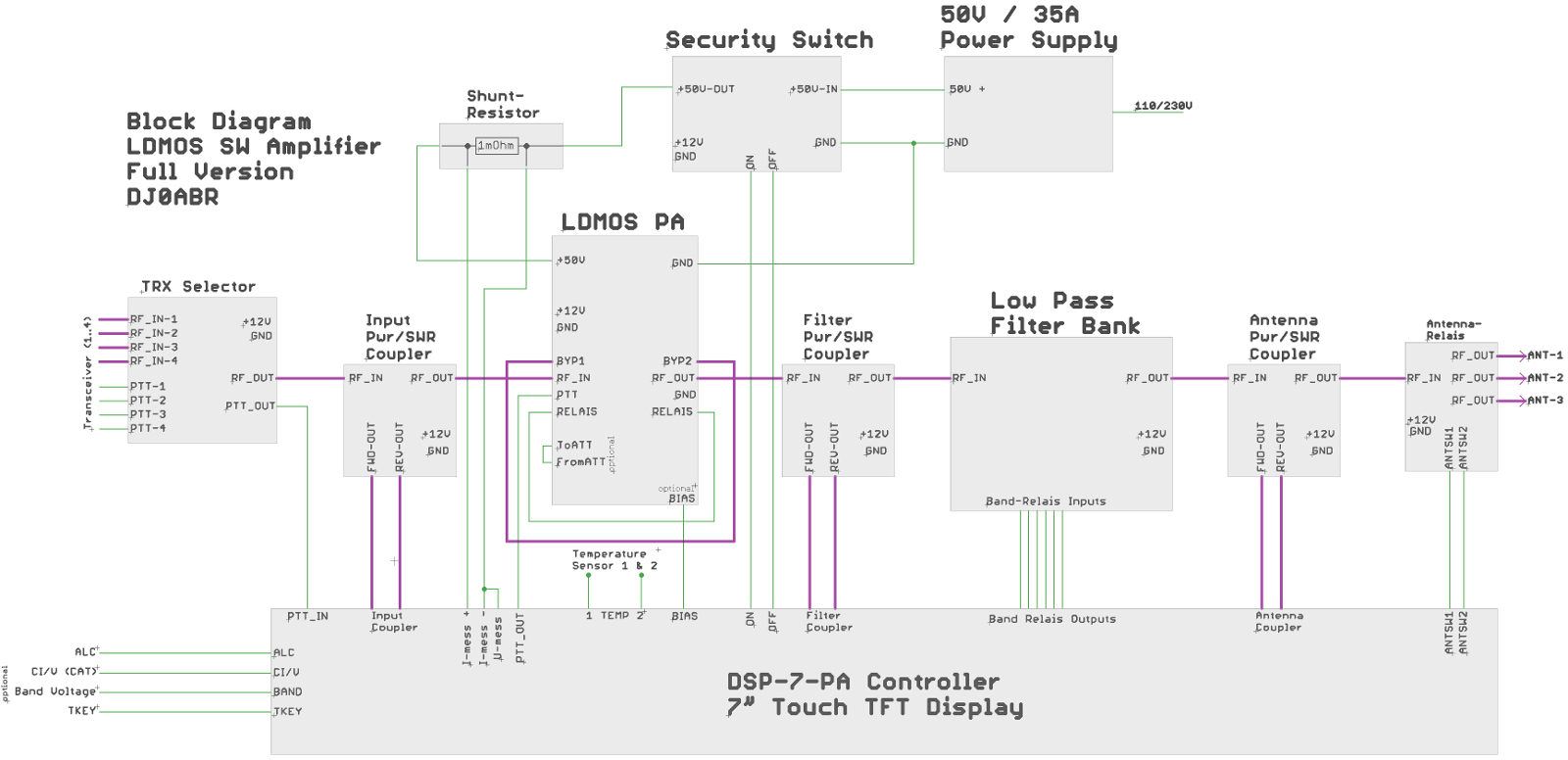Sidebar
Table of Contents
DSP-7-PA
Controller for amateur radio power amplifiers with large 7" TFT touch color display
and many measurement functions, sensors and WiFi webinterface
Block diagram
For all modules described here boards are available. To keep the overview here follows a block diagram and a description for the interconnection:
violet connections: Coax cable, green connections: normal switching wire.
RF from input to output:
Up to 4 transceivers can be connected to the TRX selector module. The transceiver where the PTT was pressed last gets the connection. (The module is of course optional, you can just as well use a manual switch).
the RF then goes to the input Pwr/SWR coupler. The purpose of this coupler is to monitor the input power. It is guaranteed that sometimes the transceiver is set to 100W and transmits into the PA, resulting in smoke signals. If you have this input Pwr/SWR coupler, the controller can switch off the PA in case of an error and switch the transceiver directly to the antenna.
From the coupler it goes directly to the PA.
Since the control power from the trasceiver is practically always much too high, you need an input attenuator. There are two alternatives: The PA has the connections FromATT and ToATT, here you can loop in a 10dB attenuator from normal 3W resistors. But if you use the TRX selector module, this attenuator is already provided there. In this case you can connect FromATT and ToATT directly.)
After the PA follows another coupler, the Filter-Pwr/SWR coupler. The purpose of this coupler is to detect a wrongly switched or defective filter. If possible, the filter will be switched automatically. Nevertheless it happens sometime that one selects the wrong one, and then this coupler helps to avoid damages, because the controller switches off immediately.
Moving on to the filter bank. There are 6 switching outputs available which are sufficient to switch 7 filters. The controller has different band combinations and thus supports different filter configurations.
Behind the filter comes the third coupler, the antenna pwr/SWR coupler. Here, as usual, power and SWR are measured at the antenna.
Finally, at the output is the antenna switch. If you have more than one antenna, the controller can automatically switch to the appropriate antenna depending on the band.
Power supply:
Right after the 50V power supply comes the safety switch. Apart from switching the PA supply on/off, this switch can cut off the supply in a very short time if an adjustable load current is exceeded. This is a matter of health and safety. You should not do without this safety measure under any circumstances, apart from the protection of the expensive LDMOS transistors. Via the ON/OFF lines the controller can switch on the 50V supply and switch it off immediately in case of an error (emergency stop mode).
Between the output of the circuit breaker and the PA is a 1 milliohm high load precision resistor (manufacturer: Isabellenhütte, available from www.helitron.de/shop ). The current into the PA generates a voltage drop across the shunt which is measured by the controller. At the same time the supply voltage of the PA voltage is also measured via the connection U-mess.
Temperature measurement:
with the help of the measured temperature on the one hand a fan (or water pump) is switched on/off and on the other hand an emergency shutdown takes place if the temperature exceeds a high threshold value. The controller DSP-7-PA has two inputs for temperature sensors (NTC type: B57703M103G, see Conrad.de). One sensor is usually screwed onto the heat sink, the other one in close proximity to the power transistors.
Antenna switching:
The controller DSP-7-PA allows the assignment of bands to antennas. Via the lines ANTSEL1 and 2 the controller controls the switching relays.
further connections:
BIAS: shortly before transmitting, a voltage of approx. 12V is present here. From this voltage the BIAS bias voltage of the power stage transistors can be generated. The BIAS line is controlled by the PTT and by the safety shutdown. (In the power amplifiers I built, this output is not used and remains unconnected because the BIAS control is already included on the power amplifier).
ALC: outputs a negative voltage to limit the power of the transceiver. Connect to the ALC input of the transceiver. The response point can be adjusted with a potentiometer on the controller board.
CI/V: Icom CAT Interface. If this connector is connected to CI/V of an Icom transceiver, band switching is fully automatic.
BAND voltage: If the CI/V interface of the transceiver is already occupied, the automatic band switching can also be done via the BAND line which is connected to the DATA socket of Icom transceivers.
TKEY: the TKEY line is used by remote controlled tuners to indicate the tuning process. If this line is connected to the controller, the power amplifier is automatically switched off during a tuning process and the transceiver is connected directly to the antenna. This allows tuning to be performed safely without a power amplifier.
Connection lines on the PA:
RELAY: these two connectors are connected with a simple wire. It is the control line for the output relay to activate it when sending.
BYP-1 and BYP-2: these two connectors are connected with a piece of thin coaxial cable. The antenna signal runs over this wire in receive mode.


